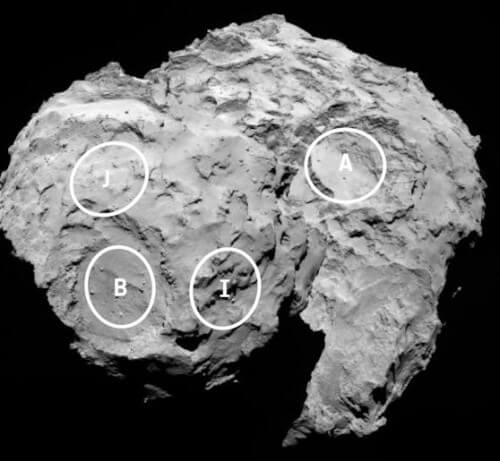Images taken by the European Space Agency's Rosetta spacecraft of the surface of comet 67P Churyumov-Gardimenko have helped the European Space Agency select five alternative sites for the Philae lander that will detach from the Rosetta spacecraft and land in November, a landing that is expected to be the first of its kind.

Images taken by the European Space Agency's Rosetta spacecraft of the surface of comet 67P Churyumov-Gardimenko have helped the European Space Agency select five alternative sites for the Philae lander that will detach from the Rosetta spacecraft and land in November, a landing that is expected to be the first of its kind.
"This is the first attempt to land on a comet," said Stefan Olmek, director of the Philae landing at the German Space Center in Cologne. "The candidate sites we want to follow for further analysis are those that technically will be easy to land on, thanks to the analysis of the flight dynamics. Landing on each of these sites will provide us with at least six hours of light in the entire orbit of the comet and they are also relatively flat areas. Of course, every site has the potential for unique scientific discoveries." said.
For each of the sites we need to ask ourselves important questions: Will the lander be able to maintain regular communication with Rosetta? How common are surface obstacles such as large cliffs, deep trenches or steep slopes? Is there enough lighting to operate the scientific instruments and enough sunlight to recharge the batteries beyond their 64 hour life without causing overheating?
The five sites were selected from a longer list that included ten sites. Three sites (B, I and J) are on the smaller of the two parts of the comet and the others (A and C) are on the larger arm.
"The process of choosing the landing site is complex and dynamic, as we get closer to the comet we notice more and more details, which may affect the final choice of where to land" says Fred Jensen, director of the Rosetta program at the European Space Agency's Science and Technology Center in Noordwijk, the Netherlands. "We must finish the analysis and select the site quickly upon arrival at the comet, and now we only have a few weeks to determine the primary site. The clock is ticking and we must meet the challenge of choosing the best landing site."
The next step will be an examination of all the sites, in order to determine a possible route and preparation strategies that will allow Rosetta to launch the lander to each of them, at the same time, Rosetta will approach a distance of 50 kilometers from the face of the comet and the Babbar will allow a detailed study of the proposed landing sites. By September 14, the five sites will be ranked and edited and progress will be made towards the selection of the main site, as well as the content of a backup plan.
Philae's landing is expected to take place in mid-November when the comet will be 450 million km away from the sun, and before the start of accretion to its peak activity, which could damage the stability of the lander and before the materials on the surface change due to the comet's activity.
Rosetta is a mission of the European Space Agency with the support and assistance of instruments provided by NASA.
For information on the NASA website
The promotion page on the European Space Agency website
http://rosetta.jpl.nasa.gov. The ESA’s Rosetta home page is at .

2 תגובות
Landing area B seems to be the most ideal in terms of soil texture and slope. My personal opinion... they won't find anything there, only sand. Rocks ..not really different from the soil structure of the moon...
I choose landing zone B 🙂